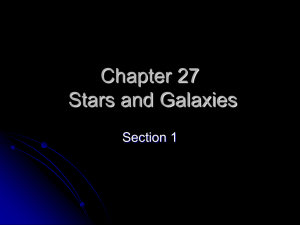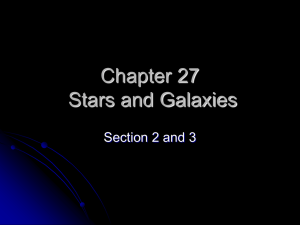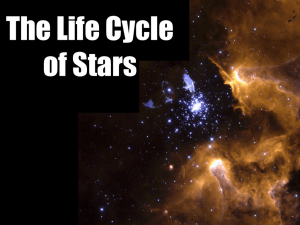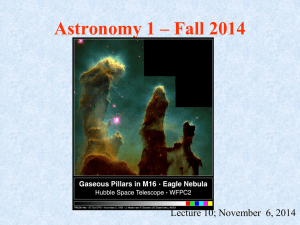Chapter 15 part 1
advertisement
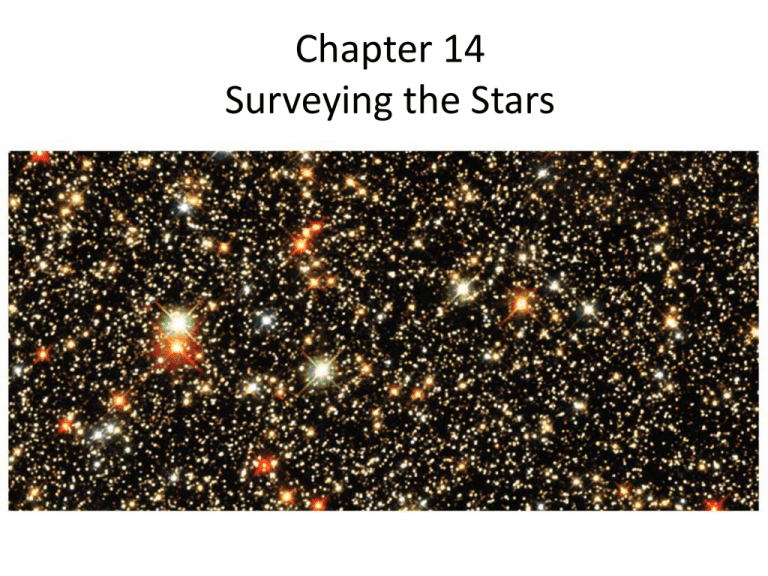
Chapter 14 Surveying the Stars Luminosity and Apparent Brightness Luminosity - the measurement of the rate at which energy is outputted from a star. This could also be called the power output of the sun. 𝐿 = 𝜎𝐴𝑇 4 = 4𝜋𝜎𝑟 2 𝑇 4 Where: 𝜎 = 5.67•10−8 𝑊 𝑚2 𝐾 4 (Stefan-Boltzmann constant) 𝐴 = 4𝜋𝑟 2 = The surface area of the star with a radius 𝑟 𝑇 = the temperature of the star in Kelvin However, when we look at a star, we see not its luminosity but rather its apparent brightness Apparent brightness is a measure not of a star’s luminosity but of the energy flux (energy per unit area per unit time) produced by the star, as seen from Earth. It depends on our distance from the star. Thought Question These two stars have about the same luminosity -which one appears brighter? A. Alpha Centauri B. The Sun Luminosity: Amount of power a star radiates (energy per second = Watts) Apparent brightness: Amount of starlight that reaches Earth (energy per second per square meter) Luminosity passing through each sphere is the same Divide luminosity by the area of the sphere over which the light is being spread to get the apparent brightness at every point on that sphere. The further from the star your go the larger the area over which the light is spread so the dimmer the star will appear to be. The relationship between apparent brightness and luminosity depends on distance: Brightness = Luminosity 4π (distance)2 Thus we can determine a star’s luminosity if we can measure its distance and apparent brightness: Luminosity = 4π (distance)2 x (Brightness) Thought Question How would the apparent brightness of Alpha Centauri change if it were three times farther away? A. B. C. D. It would be only 1/3 as bright It would be only 1/6 as bright It would be only 1/9 as bright It would be three times brighter Most luminous stars: 106 LSun Least luminous stars: 10-4 LSun (LSun is luminosity of Sun) So how far are these stars? Parallax Apparent positions of nearest stars shift by about an arcsecond as Earth orbits Sun Parallax angle depends on distance Parallax and Distance p = parallax angle d (in parsecs) d (in light - years) = 1 p (in arcseconds) = 3.26 1 p (in arcseconds) Our nearest neighbours The closest star to Earth (besides the Sun) is called Proxima Centauri. It has the largest known stellar parallax, 0.76'', which means that it is about 1/0.76 = 1.3 pc away— about 270,000 A.U., or 4.3 light-years. Our next nearest neighbor to the Sun beyond the Alpha Centauri system is called Barnard’s Star. Its parallax is 0.55'', so it lies at a distance of 1.8 pc, or 6.0 light-years. Stellar Motion we must be careful with parallax. Barnard’s Star 22 years apart: This stellar motion has two components. A star’s radial velocity—along the line of sight—can be measured using the Doppler effect. For many nearby stars, the transverse velocity—perpendicular to our line of sight—can also be determined by careful monitoring of the star’s position on the sky. The annual movement of a star across the sky, as seen from Earth and corrected for parallax, is called proper motion. It describes the transverse component of a star’s velocity relative to the Sun. Like parallax, proper motion is measured in terms of angular displacement Spectral lines from Alpha Centauri are blueshifted by a tiny amount—about 0.0067 percent—allowing astronomers to find the radial velocity from the Doppler Effect Use basic trig to find the hypotenuse. THE MAGNITUDE SCALE The scale dates from the second century B.C., when the Greek astronomer Hipparchus ranked the naked-eye stars into six groups. The brightest stars were categorized as first magnitude. The 1–6 magnitude range defined by Hipparchus spans about a factor of 100 in apparent brightness—a first-magnitude star was approximately 100 times brighter than a sixth-magnitude star. The physiological characteristics of the human eye are such that each magnitude change of 1 corresponds to a factor of about 2.5 in apparent brightness. [ 2.512 to the fifth power is 100] We now define a change of 5 in the magnitude of an object (going from magnitude 1 to magnitude 6, say, or from magnitude 7 to magnitude 2) to correspond to exactly a factor of 100 in apparent brightness. Because we are really talking about apparent (rather than absolute) brightnesses, the numbers in Hipparchus’s ranking system are called apparent magnitudes. The scale is no longer limited to whole numbers Absolute magnitude To compare intrinsic, or absolute, properties of stars, however, astronomers imagine looking at all stars from a standard distance of 10 pc (arbitrary choice). Because the distance is fixed in this definition, absolute magnitude is a measure of a star’s absolute brightness, or luminosity. Knowing distance allows us to compute its absolute magnitude. As discussed further in lab the numerical difference between a star’s absolute and apparent magnitudes is a measure of the distance to the star The Magnitude Scale m = apparent m agnitude M = absolute m agnitude apparent brightness of S tar 1 (100 1/ 5 ) m1 m 2 2.51 m1 m 2 apparent brightness of S tar 2 lum inosity of S tar 1 lum inosity of S tar 2 (100 1/ 5 ) M1M 2 2.51 M1M 2 How do we measure stellar temperatures? Blackbody Radiation 1. Hotter objects emit more light per unit area at all frequencies. (Brighter) 2. Hotter objects emit photons with a higher average energy. (Bluer) Hottest stars: 50,000 K Coolest stars: 3,000 K (Sun’s surface is 5,800 K) Absorption lines in star’s spectrum tell us ionization level which is highly dependent on temperature. Pioneers of Stellar Classification • Annie Jump Cannon and the “calculators” at Harvard laid the foundation of modern stellar classification Early computers were not allowed to be Laptops Harvard “computers” were ladies who did the tedious data analysis by hand. 1897: Antonia Maury spectral study led to HR diagrams. 1898: Annie Cannon’s spectral classes still used. She ranked stellar spectra based on the strength of the Hydrogen spectral lines. 1908: H. Leavitt’s variable star work . Lines in a star’s spectrum correspond to a spectral type that reveals its temperature The original classification of spectral type was alphabetical and based on the strength of the hydrogen lines. Spectra with the strongest hydrogen lines were call A type stars. Spectral Types in Temperature Order (Hottest) O B A F G K M (Coolest) •Only Boys Accepting Feminism Get Kissed Meaningfully Each spectral type is subdivided into numbered subcategories (0-9) 0 being the hottest and 9 the coolest. For example; if we break the F spectral type stars into its subcategories the order would look like O B A (F0, F1, F2…, F9) G K M The sun is a G2 spectral class star. How do we measure stellar masses? The orbit of a binary star system depends on strength of gravity Types of Binary Star Systems • Visual Binary • Eclipsing Binary • Spectroscopic Binary About half of all stars are in binary systems Visual Binary We can directly observe the orbital motions of these stars Eclipsing Binary We can measure periodic eclipses Spectroscopic Binary We determine the orbit by measuring Doppler shifts Alcor and Mizar are optical doubles not true binaries. They just look close. But Mizar A & B is a true visual binary made up of two spectroscopic binaries (4 stars total). Estimating Stellar Masses Recall Kepler’s 3rd Law: 4𝜋 2 𝑎3 2 𝑃 = 𝐺(𝑀1 + 𝑀2 ) If we choose to measure the Period in years, the average orbital separation in astronomical units (AU), and the masses in solar masses then the constants 4𝜋2 𝐺 =1 So 𝑎3 𝑀1 + 𝑀2 = 2 𝑃 Example: A binary system is observed with a period of P = 32 years and separation a of a = 16 AU: 𝑎3 𝑀1 + 𝑀2 = 2 𝑃 163 𝑀1 + 𝑀2 = 322 = 4 solar masses Need 2 out of 3 observables to measure mass: 1) Orbital Period (P) 2) Orbital Separation (a or r = radius) 3) Orbital Velocity (v) v For circular orbits, v = 2pr / p r M Most massive stars: 100 MSun Least massive stars: 0.08 MSun (MSun is the mass of the Sun) Back to Stellar Masses. • We can add mass to the data we have on stars thanks to the binaries. • We find… • Supergiants, giants and white dwarfs reveal no clear pattern. • But main sequence stars show a clear trend. MAIN SEQUENCE STARS ONLY (a) Size and mass relation (b) Luminosity and mass What have we learned? • How do we measure stellar luminosities? – If we measure a star’s apparent brightness and distance, we can compute its luminosity with the inverse square law for light – Parallax tells us distances to the nearest stars • How do we measure stellar temperatures? – A star’s color and spectral type both reflect its temperature What have we learned? • How do we measure stellar masses? – Newton’s version of Kepler’s third law tells us the total mass of a binary system, if we can measure the orbital period (p) and average orbital separation of the system (a)


